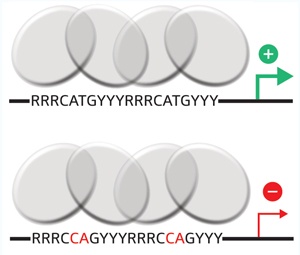
Fig. 1: Schematic illustration showing that just a few sequence elements determine whether p53 (grey circles) acts as an activator or repressor of downstream target genes. Changes in a dinucleotide pair (red letters) within the binding site are sufficient to change the p53RE from an activator (top) to a repressor (bottom).
© 2009 A*STAR
Scientists have been studying tumor suppressor p53 for 30 years now, but this protein still holds many secrets. For example, it has long been established that a canonical sequence of nucleotides marks genes as targets for transcriptional regulation by p53. Now, however, Ee Chee Ren at A*STAR’s Singapore Immunology Network and his co-workers have revealed additional levels of unexpected regulatory complexity.
While characterizing the regulation of Lasp1, a gene associated with metastatic liver cancer, Ren’s team observed evidence for p53-mediated repression—but with a twist. “The p53 binding sites in the promoter had an unusual sequence and did not fit exactly with the known canonical p53 response element,” he says. “We decided to test it and, more importantly, confirm that it does repress the downstream gene.”
The core of the p53 response element (p53RE) consists of a pair of ten-nucleotide stretches (decamers). The researchers began by testing the regulatory effects of swapping segments of these ten decamers from the repressive Lasp1 p53RE with counterpart sequences from the p21 gene, where p53RE acts as an activator. These experiments revealed that the key determinant of whether these motifs turn a gene on or off can be traced back to a single nucleotide pair, and that modifying this nucleotide combination is sufficient to turn an activating p53RE into a repressor, or vice versa (Fig. 1).
“This illustrates how frequently in nature, what may seem very complicated at first eventually turns out to be simple and elegant,” says Ren. The sequences adjacent to the dimer were also found to have a prominent, though less meaningful overall, role in steering p53 activity.
Numerous p53REs have been described in the literature, and nearly 88% of the 162 regulatory elements examined obey the rules determined by Ren’s team. The researchers were even able to reveal inaccuracies in the current functional descriptions of 20 of these p53REs, and subsequently confirmed these misclassifications experimentally. “By applying the rules we have generated, a much higher percentage of p53 target genes turned out to be repressed rather than activated,” says Ren. “This means that cellular physiology involving p53 pathways can be better understood in cases where p53 is damaged or deleted in cancer.”
These findings overturn long-standing assumptions that ‘one p53RE fits all’ for both activation and repression, and raise questions about how sequence affects function. “Possible mechanisms could involve different co-factor recruitment and/or conformational changes for the p53 protein,” says Ren. “However, these hypotheses need further experimental investigation.”
The A*STAR-affiliated authors in this highlight are from the Singapore Immunology Network.



